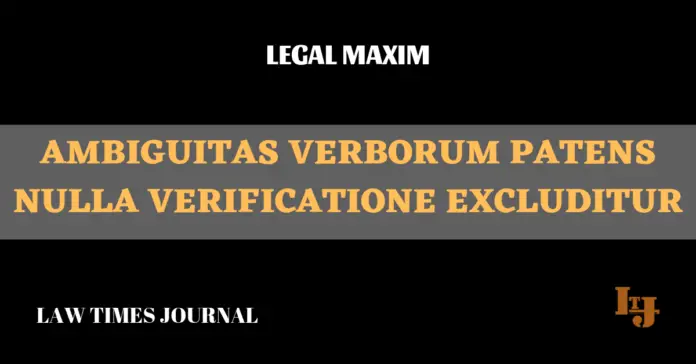
Literal Meaning
A patent ambiguity is never helped by averment.
Explanation & Origin
Ambiguitas verborum patents nulla verificatione excluditur is a legal maxim in Latin.
Legal maxim and Latin for a patent ambiguity is never helped by averment or extrinsic evidence.
That which is patently ambiguous on its face cannot be made clear by external proof.
Patent ambiguity is an uncertainty that appears on the face of the document. It cannot be removed by proof.
The term ambiguity may be either latent or patent. It is the former , where the language employed is clear and intelligible and suggests but a gingle meaning , but some extrinsic fact or extraneous evidence creates a necessity for interpretation or a choice among two or more possible meanings.
But a patent ambiguity is that which appears on the face of the instrument , and arises from the defective , obscure or insensible language used.
The following commentary by Lord Bacon is recognised basis of the law governing the subject. There be two sorts of ambiguities of words , the one is ambiguitas patens , and the other latens. Patens is that which appears to be ambiguous upon the deed or instrument ; latens is that which seemeth certain and without ambiguity ,for anything that appeareth upon the deed or instrument.
Ambiguitas Verborum Patens Nulla Verificatione excluditur is a legal maxim, used in India, with the following meaning: A patent ambiguity in the words of a written instrument cannot be cleared up by evidence extrinsic to the instrument.
Illustration
A testator devises his manor of dale and he has two manors of that name ; or where he bequeaths property to his cousin , A. B and he has two cousins of that name ; or where persons contract with reference to a ship peerless and it appears that there are two of that name.
Case Reference
Allegheny Int’l vs. Allegheny Ludlum Steel Corp., [(3d Cir. 1994)].
This case defines a patent ambiguity is that which appears on the face of the instrument, and arises from the defective, obscure, or insensible language used. In contrast, a latent ambiguity arises from extraneous or collateral facts which make the meaning of a written agreement uncertain although the language thereof, on its face, appears clear and unambiguous.
Ward vs. Epsy [6 humph (tenn) 447]
In this case ambiguity was defined as a doubleness of meaning ; indistinction or uncertainty of meaning of an expression used in a written instrument.
Eatherly vs. Eartherly [cold. (tenn) 461]
In this case an ambiguity in relation to the very foundation of the instrument itself , as distinguished from an ambiguity in regard to the construction of its term. The term is applied , for instance , to a doubt as to whether a testator meant a particular clanse to be part of the will , or whether it was introduced with his knowledge or , whether a codicil was meant to republic a former will , or whether the residuary clause was accidentally omitted.
Edited by Vigneshwar Ramasubramania
Approved & Published – Sakshi Raje





